It looks like you're using an Ad Blocker.
Please white-list or disable AboveTopSecret.com in your ad-blocking tool.
Thank you.
Some features of ATS will be disabled while you continue to use an ad-blocker.
share:
O.k I'll take the hint.
Cicada I apologize for my part in taking this thread off track . I did think it was a really good thread and still do. I didn't mean for any of this argument to get personal . I really think the differences between your POV and mine are fairly trivial. So I didn't mean to get into this type of disagreement at the detriment of your thread. I am sorry.
So I will sit back in the shadows and let you continue taking this thread in the direction you want to go with it.
Cicada I apologize for my part in taking this thread off track . I did think it was a really good thread and still do. I didn't mean for any of this argument to get personal . I really think the differences between your POV and mine are fairly trivial. So I didn't mean to get into this type of disagreement at the detriment of your thread. I am sorry.
So I will sit back in the shadows and let you continue taking this thread in the direction you want to go with it.
Seeing as how there is no longer any one contending that the 1235 General "Yoritsume" event was an actual occurrence it seems it is time to move on.
I'm still hoping to uncover a source for the account beyond Yusuke J. Matsumura. If I am able to find something I will share it on this thread.
I'm not particularly hopeful but if such a thing could be found it could potentially clear up several contentious matters on the topic. Personally,
I find the fact that the various UFO timelines are willing to label this event as the first government investigation of UFO phenomena to be rather
demonstrative of the poor quality of information they are willing to disseminate as factual.
The next item to be discussed should be apparent. I was prepared to make a presentation of my findings at this time but was fortunate enough yesterday to find images of the original text from which the passage in question was taken. The text is in Latin and the images are jpegs so I'll have to transcribe it for any potential translation. While I doubt with my limited knowledge of Latin that I will be able to perform much of a translation, even with online language tools, I figure it is worth a shot for an opportunity to see what was actually said. It seems there are merely two short pages under consideration so I hope to be able to present something within the next few days.
The next item to be discussed should be apparent. I was prepared to make a presentation of my findings at this time but was fortunate enough yesterday to find images of the original text from which the passage in question was taken. The text is in Latin and the images are jpegs so I'll have to transcribe it for any potential translation. While I doubt with my limited knowledge of Latin that I will be able to perform much of a translation, even with online language tools, I figure it is worth a shot for an opportunity to see what was actually said. It seems there are merely two short pages under consideration so I hope to be able to present something within the next few days.
originally posted by lost_shaman
1528:
At the Siege of Utrecht in Holland " A cruel and strange sight was seen in the sky, which terrified the townspeople and made the enemy think he would get the city. It was the form of a Burgundian cross right over the city, high in the sky, yellow in color, and fearful to behold."
Of the three "historical sightings" posted by lost_shaman way back on page one of this thread this is my absolute favorite. 1528 CE was an extremely important year in the history of the city and province of Utrecht. Prior to this year Utrecht was an independent territory secularly ruled by its Catholic bishop.
In 1506 CE Charles V
inherited the Burgundian provinces (the bulk of the Low Countries) from his father, Phillip the Handsome. After the death of his maternal grandfather, Ferdinand II of Aragon (famed sponsor of the 1492 voyage of Columbus), in 1516 Charles became the first king of a united Spain. With the death of his paternal grandfather, Holy Roman Emperor Maximilian I in 1519 he inherited the Hapsburg territories in Austria. On June 28th of that year Charles was named Holy Roman Emperor. He placed his territories in the Netherlands under the stewardship of his aunt Margaret of Austria and later his sister Mary of Hungary. Over time Charles annexed additional independent cities and provinces of the Low Countries into his kingdom. In 1528 the Catholic bishop of Utrecht sold control of Utrecht to Charles V. While there is little information available on the details of this transaction it seems it did come through the application of armed force. On June 30th, 1528 the forces of Charles V occupied the city of Utrecht. This is apparently the event during which the supposed sighting occurred.
Here is an example of a Burgundian Cross:

A more detailed history of the House of Burgundy is available at the Catholic Encyclopedia: Burgundy
You'll note that the description of the sighting provided indicates that the sight of the Burgundian cross "made the enemy think he would get the city". The reason for this is rather obvious as it was in the form of one of their own representative symbols. What are we to imagine was taking place in this account then? Was the form of the UFO just an incredible coincidence or was this some intentional expression of prophecy or preference for the Holy Roman Empire? On this level alone the details of the account itself suggests the expression of an urban legend or even the fragments of a program, systematic or otherwise, of presenting the exchange of power over the territory as the fulfillment of Divine Will.
After searching through several UFO timelines I happened upon a reference for this particular story. It was attributed to a writer named Wolffhart. Further research soon revealed the full identity of this individual, who while highly obscure turns out to be one of the most fascinating figures of the Renaissance, Conrad Wolffhart, more commonly known as Conrad Lycosthenes (link translated from German by Google), the Greek version of his name.
The volume from which the account is derived is the
Prodigiorum ac ostentorum chronicon (The Chronicle of Wonders). This incredible work was presented as a collection of hundreds of events taken to be omens from throughout known history. It was published in 1557 in Basle, Switzerland (29 years after the supposed event took place).
Lycosthenes was a philologist, a professor of grammar and dialect, a deacon, a philosopher, a theologian and an editor for a translation of Ptolemy's "Geographia" and Julius Obsequens' "Book of Prodigies" (another figure whose work is frequently presented as recording historical UFO events).
"The Chronicle of Wonders" covers the entire span of history as conceived by Christian dogma, from the fall from Eden (reckoned as occurring in 3959 BC) to the date of its publication. Lycosthenes drew from numerous sources including ancient works, such as those of
Pliny the Elder, and contemporary cosmographers, naturalists, philosophers and occultists, including
Paracelsus.
That the volume included accounts potentially based on fact alongside those that are patently fictitious is apparent upon reviewing the work itself. Many of the "monstrous births" held to be omens of upcoming events can be reconciled as superstitious reactions to rare but naturally occurring birth defects in humans and animals, such as varying forms of partial or full conjoined twins. Many others can only be read as great distortions of original fact or outright fabrications. Accounts of miraculous and mythological creatures and events from Christian and other sources abound. Here are a few examples:
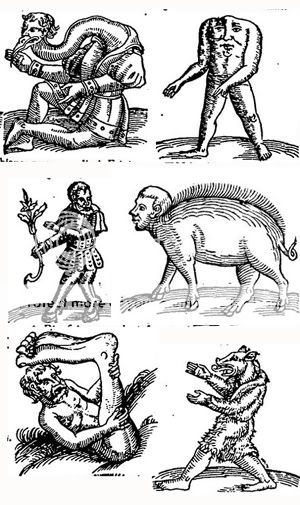

Lycosthenes also includes an account of the Monster of Cracow, previously presented in works by Sebastian Munster and Jacob Ruff. The monster was supposedly born in 1540 with living, barking dog heads growing from its elbows, knees and chest. It died four hours after its birth after warning, "Watch, the Lord Cometh".
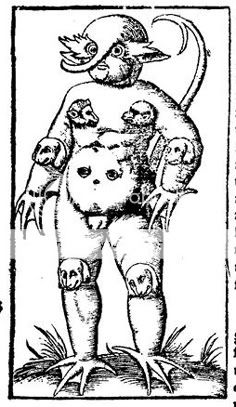
That Lycosthenes' interests were not purely historical, that they were in fact at times allegorical, is evidenced through an example presented in the article Monsters in A Chronicle of Wonders (translated from French by Google). Amongst the monstrous births are two figures, presented separately, that originated in a pamphlet satirizing the Roman Catholic Church published in 1540 by Martin Luther and Philipp Melanchthon, and illustrated by
Lucas Cranach the Elder.
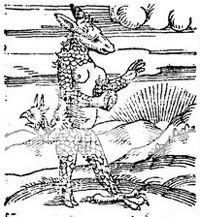
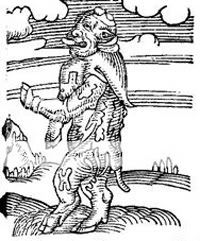
(note: These are the illustrations from "The Chronicle of Wonders, not those of Cranach)
In the pamphlet the "ass-pope" and the "monk-calf" are presented as omens of the pending fall of the Roman Catholic Church. This satire was easy to understand and was widely known throughout Europe by the publication of "The Chronicle of Wonders". It is notable that Lycosthenes chose to present the entities as factual beings, making no mention of the context in which they originated. While it is possible that the monk-calf represented a true deformed calf birth, the figure of the ass-Pope is clearly impossible and is known to have been generated at Luther's request by Cranach. Their inclusion in Lycosthenes' volume was obviously polemical.
Here are the pages from "The Chronicle of Wonders" that detail the Utrecht event:

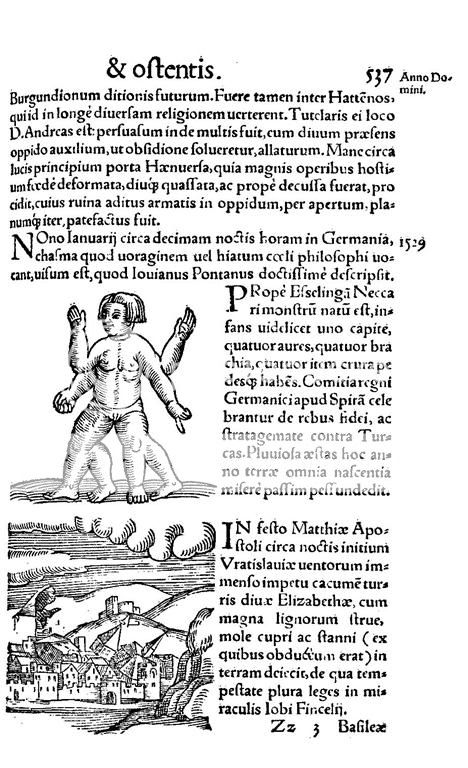
As stated in the last post, the work was written in Latin. There was an English version published in 1581 but I was initially unable to access the links to the only online copy of it I could find. Thankfully I was able to navigate my way to the page saving me from a most probably futile translation effort (I started but saw immediately how difficult it was going to be. Due to the crude printing technology the spacing between words is not always apparent and several of the characters used were unfamiliar and not reproducible).
The translation was performed by Dr. Stephen Batman (coolest surname ever) and published as The Doome: Warning All Men to Judgment, and included further accounts from the British Isles and events in of the 34 years since the publication of "The Chronicle of Wonders".
Here are the pages from Batman:

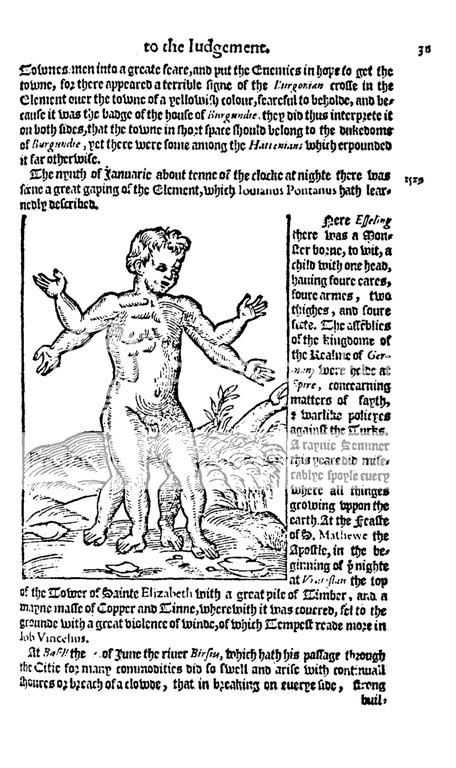
The Utrecht account begins at the bottom of page 310 and continues at the top of page 311. Note that Lycosthenes and Batman's works feature different illustrations of the same monstrous birth immediately after the account. Also note how the Batman refers to the Burgundian cross as an emblem of the House of Burgundy, read by both sides as an indication of their victory over the territory. The Hallenians referred to are apparently people from the German city of Halle, some 100 miles from Utrecht.
For curiosity's sake here are the illustrations presented by Lycosthenes for the prophecies preceding the fall of Jerusalem in 70 CE (wrongly dated by two years by Lycosthenes and derived wholly from Joephus' "The Jewish War"):


Note that these images were not specifically generated to represent this event. They and many of other the wood block prints were used numerous times to illustrate various events throughout the book. This is also true of the Burgundian cross as Lycosthenes presents it. It should not be mistaken as an accurate depiction of the supposed sighting.
Here is another image Lycosthenes uses multiple times:

If the so-called UFOs in various works of art are examples of UFOs in history does this image not an example of giant floating heads in history?
Here is another image from "The Chronicle of Wonders" presented as representing a UFO sighting, the 1479 comet sighting in Arabia, to be discussed in greater detail at a future date:

Both "The Chronicle of Wonders" and "The Doome" were presented online on the amazingly detailed Prophecies On Line by Mario Gregorio, primarily concerned with Lycosthenes' contemporary Nostradamus.
My apologies for the grammatical typos in the last post. Here is the link to the German Wikipedia article on
Lycosthenes.
Here is the passage on the Utrecht sighting from Dr. Batman's "The Doome" in a more easily read format:
Here is the passage on the Utrecht sighting from Dr. Batman's "The Doome" in a more easily read format:
When the City of (Utrecht) was bisieged with a serious (grevious?) siege, there was seene a cruell oraunge light in the Element, whiche brake its Townes men into a greate feare, and put the Enemies in hope to get the towne, for there appeared a terrible figure of the Burgonian crosse in the Element over the towne of a yellowily colour, feareful to beholde, and because it was the badge of the house of Burgundie, they did thus interprete it on both sides, that the towne in short space should belong to the dukedome of Burgundie, yet there were some among the Hallenians which expounded it far otherwise.
At the risk of reopening old wounds, I'm going to present additional information regarding the 1235 General Yoritsume sighting. My main impetus for
returning to this subject is the extensive research performed by my associate whom I mentioned earlier. Unlike me, researching almost exclusively on
the internet, he actual goes to libraries and I'm going to present his material, thus far, in an order following the chronology of his findings.
Please note that much if not all of this involves oriental religious and philosophical concepts from 800+ years ago, so we can not expect it to
conform to our modern, occidental ideas.
In order to get a general feel for the status of astronomical theory in Japan during the Kamakura era, my associate first consulted Joseph Needham's monumental, multi-volume history of "Science and Civilization in China". The influence of China on all things Japanese almost goes without question, recognizable as demonstrated in the following article on the history of Ancient Japan by Dr. Robert Churchill. Korea and India also had great impacts on Japanese development.
In a section on theories about the structures of heaven and earth, Needham discusses the Buddhist Hsuan Yeh or Infinite Emptiness School. The only information about this online that I could find was:
From an article entitled THE EYE OF EXISTENCE by Frank R. 'Bob' Andrews.
Needham states that "In the 11th and 12th centuries, Shao Yung and Chu Hsi constantly refer to the 'hard wind' in the heavens which supports the luminaries and bears them on their way". Chu Hsi (also written Zhu Xi) considered this a concept of Taoism, the '"hard wind" referring to the pure Ch'i (in this instance considered as motion/energy) of the heavens. Here also is the Wikipedia article on the fascinating, and apparently controversial, Shao Yung.
In a second round of research at a larger library my associate located a copy of Shigeru Nakayama's "A History of Japanese Astronomy: Chinese Background and Western Impact" (1969, Harvard University Press). According to Nakayama, the Buddhist community of Japan was still using a Hindu Cosmology system that conceptualized the celestial objects as revolving around the central axis of Mt. Meru, propelled, in Nakayama's words, "by a divine wind".
Through his research my associate got a pretty good concept of how the intellectual community of Kamakura era Japan functioned:
It is the opinion of my associate that the account given by Yusuke J. Matsumura is legitimate, but that Matsumura misrepresented the story for his own rhetorical purposes.
If the incident did occur, then the explanation that the "wind made the stars sway" is the answer we should expect.
In order to get a general feel for the status of astronomical theory in Japan during the Kamakura era, my associate first consulted Joseph Needham's monumental, multi-volume history of "Science and Civilization in China". The influence of China on all things Japanese almost goes without question, recognizable as demonstrated in the following article on the history of Ancient Japan by Dr. Robert Churchill. Korea and India also had great impacts on Japanese development.
In a section on theories about the structures of heaven and earth, Needham discusses the Buddhist Hsuan Yeh or Infinite Emptiness School. The only information about this online that I could find was:
A remarkable Chinese scholar, Ko-Hung (c300 AD) who was knowledgeable in Astronomy, wrote an interesting passage which is preserved in the ‘Chin-Shu’ (A book of the History of the Chin Dynasty) on the Chinese philosopher Chhi Meng who was an exponent of the’ Hsuan-Yeh’ or ‘Infinite Emptiness School’. Chhi Meng flourished around 100AD and had a very clear vision of infinite space. He taught that celestial bodies such as the Earth, Moon, Sun and Stars were composed of condensed vapour floating freely in empty space. His ideas and teachings were really more enlightened than the Aristotelian/Ptolemaic conception of geocentricity.
From an article entitled THE EYE OF EXISTENCE by Frank R. 'Bob' Andrews.
Needham states that "In the 11th and 12th centuries, Shao Yung and Chu Hsi constantly refer to the 'hard wind' in the heavens which supports the luminaries and bears them on their way". Chu Hsi (also written Zhu Xi) considered this a concept of Taoism, the '"hard wind" referring to the pure Ch'i (in this instance considered as motion/energy) of the heavens. Here also is the Wikipedia article on the fascinating, and apparently controversial, Shao Yung.
In a second round of research at a larger library my associate located a copy of Shigeru Nakayama's "A History of Japanese Astronomy: Chinese Background and Western Impact" (1969, Harvard University Press). According to Nakayama, the Buddhist community of Japan was still using a Hindu Cosmology system that conceptualized the celestial objects as revolving around the central axis of Mt. Meru, propelled, in Nakayama's words, "by a divine wind".
Through his research my associate got a pretty good concept of how the intellectual community of Kamakura era Japan functioned:
During the time of Imperial domination, bureaus of astronomical knowledge were set
up on the Chinese model, one for calendar making and one for divination. The control of these were given to noble houses as their income and raison d'être, and the noble families in question (Abe and Tsuchimikado for divination, Kamo and later Koutoki for calendar making) maintained the Chinese astronomical they had started with as best they could. (Astronomical divination was not too popular in the Kamakura, though. It was far behind sukuyoudou, the Buddhist methods of divination). Meanwhile Zen teachers were coming across from China and many of them had secular Neo-Confucian learning as well.
It is the opinion of my associate that the account given by Yusuke J. Matsumura is legitimate, but that Matsumura misrepresented the story for his own rhetorical purposes.
If the incident did occur, then the explanation that the "wind made the stars sway" is the answer we should expect.
Anyone ever read a booK called, "God Drives a Flying Saucer"
If God is a Supreme being why did he need a radio (Ark of the Convenent) to talk through.
If God is a Supreme being why did he need a radio (Ark of the Convenent) to talk through.
Cicada,
Thanks for the additional info Re: 1235 General Yuritsune (sic?).
This turned up today in a News article and in another ATS thread I thought I'd mention it here since it is a drawing of a UFO. Unfortunately this is the only picture I could find since the article ran today, and it has numbering imposed on to it.
www.mosnews.com...

The sketch and manuscript come from a University Professor who on September, 1, 1808 , after hearing a strange noise witnessed this object above the Kremlin.
This link is the source and has more pictures of the manuscript notes.
The interesting thing , to me, that sets this apart from other UFO Art we have discussed on this thread to date, is that this is clearly not an "Angel" or Folklore. More along the same lines as the Sandby Brothers UFO sighting , where something like a UFO was seen then sketched.
Thanks for the additional info Re: 1235 General Yuritsune (sic?).
This turned up today in a News article and in another ATS thread I thought I'd mention it here since it is a drawing of a UFO. Unfortunately this is the only picture I could find since the article ran today, and it has numbering imposed on to it.
www.mosnews.com...

The sketch and manuscript come from a University Professor who on September, 1, 1808 , after hearing a strange noise witnessed this object above the Kremlin.
This link is the source and has more pictures of the manuscript notes.
The interesting thing , to me, that sets this apart from other UFO Art we have discussed on this thread to date, is that this is clearly not an "Angel" or Folklore. More along the same lines as the Sandby Brothers UFO sighting , where something like a UFO was seen then sketched.
Not so ancient "UFO artworks", more than meets the eye.
By children of Zimbabwe.
By Tyler Wood.
Bonus. Flugkreisel schematic.
By children of Zimbabwe.
The original "Der Spiegel" artwork of the claimed Schriever's flying saucer ("Flugkreisel"). In accordance with the famous German precision, it was duly joined by details and even a cut-through view.
By Tyler Wood.
Bonus. Flugkreisel schematic.
I personally think JC was a hybrid alien of sorts. I think he was Half-annunaki and half-human. Just some crazy stuff happening back in the day.
Surfing around a few minutes ago looking for Paul Villa ufo photos I ran across this
en.wikipedia.org...
and after doing a quick ATS search found this thread. Very interesting stuff. I've seen paintings from Christiandom depicting strange ufo-like objects, but this is the first time I've seen this one. Thought I'd bump the thread.
edit: Notice the "all-seeing-eye"-like thingy below the Sputnik-like looking thingy.
[edit on 7/17/2010 by this_is_who_we_are]
[edit on 7/17/2010 by this_is_who_we_are]
en.wikipedia.org...
and after doing a quick ATS search found this thread. Very interesting stuff. I've seen paintings from Christiandom depicting strange ufo-like objects, but this is the first time I've seen this one. Thought I'd bump the thread.
edit: Notice the "all-seeing-eye"-like thingy below the Sputnik-like looking thingy.
[edit on 7/17/2010 by this_is_who_we_are]
[edit on 7/17/2010 by this_is_who_we_are]
You said the sun is always to the right of the cross and the moon is always to the left. But then you called that guy who's image you blew up for us
the "moon character" and if you look at the link of the whole painting, that character is on the right.
originally posted by: 3n19m470
You said the sun is always to the right of the cross and the moon is always to the left. But then you called that guy who's image you blew up for us the "moon character" and if you look at the link of the whole painting, that character is on the right.
You're addressing a person that hasn't been seen on ATS since Sept. 2007, so good luck getting an answer from Cicada.
I suggest you click here.
On that page you'll find that the Sun and the Moon are to be found on either side, not "always" one way or the other.
Harte
I'm posting here because this seems to be the general thread about UFO's in old paintings.
Here's one that I haven't seen mentioned before:
www.youtube.com...
It won't embed for me, but the link works.
I'm surprised this thread hasn't been more active.
Here's one that I haven't seen mentioned before:
www.youtube.com...
It won't embed for me, but the link works.
I'm surprised this thread hasn't been more active.
The first one is blood on the ground from where Christ was crucified. These are almost always misinterpreted by experimentation subjects or
interrogation victims. "Ancient Aliens" refers to the assistance of our human forefathers by archetypal regressors, which are a psychoevolutionary
(and very individually subjective) phenomenon.
But don't stop believing!
CSETI and other projects are working on analyzing waveforms and such from other galaxies, so we may eventually find someone else out there like us.
-NR
But don't stop believing!
CSETI and other projects are working on analyzing waveforms and such from other galaxies, so we may eventually find someone else out there like us.
-NR
edit on 27-5-2018 by NaturalRegressor because: (no reason given)
new topics
-
My personal experiences and understanding of orbs
Aliens and UFOs: 2 hours ago -
Matt Gaetz ready to go global thermonuclear
US Political Madness: 3 hours ago -
Research paper about plasmoids specifically calls out missing MH370 flight
General Conspiracies: 3 hours ago -
NJ Drones just another Psy-Op
Dissecting Disinformation: 5 hours ago -
Smartest Man in the World Tells His Theory About What Happens At Death
Philosophy and Metaphysics: 7 hours ago -
Covid....... Again.
Diseases and Pandemics: 9 hours ago -
US Federal Funding set to Expire December 20th. Massive CR on the way.
Mainstream News: 10 hours ago -
and14263 New Account Not the Same Old Me
Introductions: 11 hours ago
top topics
-
Covid....... Again.
Diseases and Pandemics: 9 hours ago, 11 flags -
Smartest Man in the World Tells His Theory About What Happens At Death
Philosophy and Metaphysics: 7 hours ago, 10 flags -
Matt Gaetz ready to go global thermonuclear
US Political Madness: 3 hours ago, 10 flags -
US Federal Funding set to Expire December 20th. Massive CR on the way.
Mainstream News: 10 hours ago, 8 flags -
NJ Drones just another Psy-Op
Dissecting Disinformation: 5 hours ago, 4 flags -
My personal experiences and understanding of orbs
Aliens and UFOs: 2 hours ago, 3 flags -
and14263 New Account Not the Same Old Me
Introductions: 11 hours ago, 2 flags -
Research paper about plasmoids specifically calls out missing MH370 flight
General Conspiracies: 3 hours ago, 2 flags
active topics
-
Smartest Man in the World Tells His Theory About What Happens At Death
Philosophy and Metaphysics • 21 • : BukkaWukka -
My personal experiences and understanding of orbs
Aliens and UFOs • 5 • : SteamyAmerican -
Matt Gaetz ready to go global thermonuclear
US Political Madness • 6 • : CriticalStinker -
Covid....... Again.
Diseases and Pandemics • 24 • : bscotti -
Remember These Attacks When President Trump 2.0 Retribution-Justice Commences.
2024 Elections • 117 • : Connector -
Covid Jab and the Alien Invasion
ATS Skunk Works • 20 • : FableGhost2 -
Defending the need for adherence to Old Testament commandments under the new covenant of Christ
Conspiracies in Religions • 51 • : whereislogic -
School shooting in Madison Wi.
Social Issues and Civil Unrest • 74 • : IndieA -
US Federal Funding set to Expire December 20th. Massive CR on the way.
Mainstream News • 16 • : marg6043 -
The Mystery Drones and Government Lies --- Master Thread
Political Conspiracies • 130 • : nugget1
